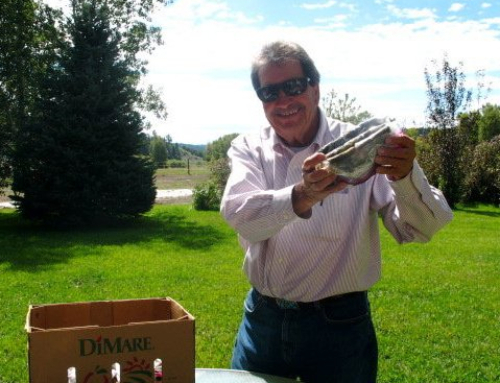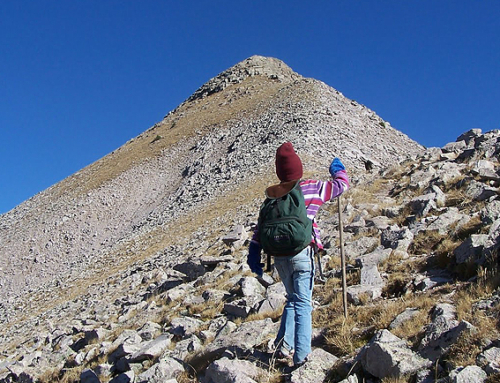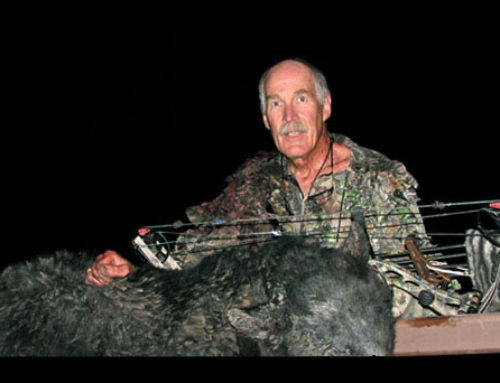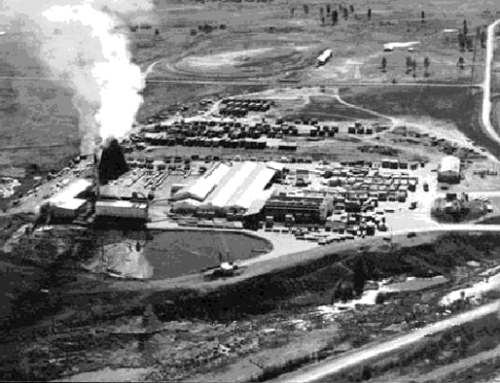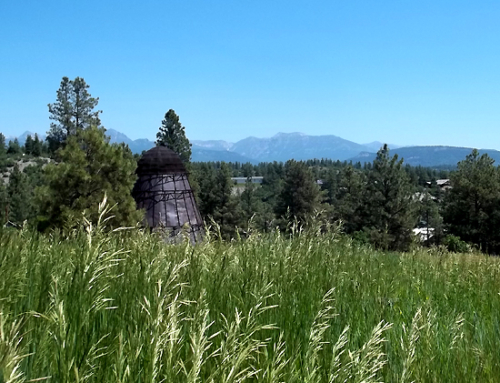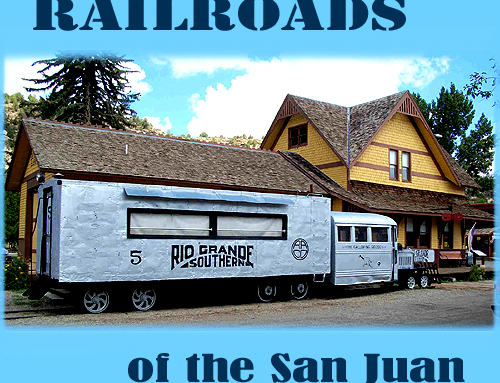This article is republished here with permission from the BRAT magazine. Originally published in 2008.
By Blue Lindner
 On a glorious fall day my sister-in-law Jenifer Pitcher, her daughters Miah and Aspen, and my son Pitcher and I drove out to Debs School House on McManus road, located just beyond the Hinsdale county line. Jenifer teaches Pagosa History to Miah, Pitcher, and their classmate Sierra Trout in homeschool. This was one of many field trips the kids have taken this fall to familiarize themselves with our region’s history.
On a glorious fall day my sister-in-law Jenifer Pitcher, her daughters Miah and Aspen, and my son Pitcher and I drove out to Debs School House on McManus road, located just beyond the Hinsdale county line. Jenifer teaches Pagosa History to Miah, Pitcher, and their classmate Sierra Trout in homeschool. This was one of many field trips the kids have taken this fall to familiarize themselves with our region’s history.
The school was one of many one-room school houses dispersed throughout our community. Debs school was open from 1909 through 1959. The existing building was built in 1930 and has been designated as a national historic site. After visiting this site, you begin to wonder if any other school exists in such a dramatic, breathtaking setting. The school is built in the shadow of two of Pagosa’s most prominent peaks: Pagosa Peak and Toner Mountain. To the west, the mountains blazed with golden aspens. To the south and east, the Piedra River Valley winds, not much more than a stone’s throw from the school house. Beyond the river to the east, the Palisade cliffs rein over the setting. The school yard contains the old sand brick building with the desks, chalk board, burlap curtains, pot belly stove, and portraits of Lincoln and Washington still intact. Behind the school is the old pump that the children used to use to gather water for hand-washing, an old wooden swing set frame, an old metal swing set frame, and a toppled over old outhouse. A stand of tall spruces to the north of the building weren’t much more than saplings when the school closed almost 50 years ago. The school yard contains many of our common alpine native plants including columbine, osha, yarrow, and rocky mountain bee plant.
The setting invoked many questions about what it must have been like to go to school there. Miah, Sierra, and Pitcher interviewed Pagosa native Dennis Kleckner, a student at the school in its final years of operation, at the Ruby Sisson Library the next day.
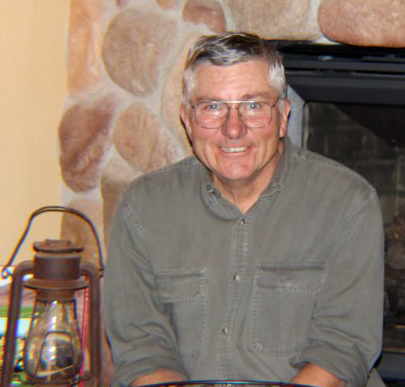
Dennis Kleckner who attended Debs School from 1952-1959
Miah: How old were you when you went to school there?
Dennis: I started when I was five and I went to school there for 6 years.
Pitcher: How far from the school did you live?
Dennis: About three quarters of a mile.
Pitcher: How did you get to school?
Dennis: We walked. Up hill both ways. Not really.
Sierra: What years did you attend Deb’s School?
Dennis: I think I started school there in 1952 and we started coming into town for school in 1959. Debs School was the last one room school house to close in the state. That’s where the “joint” came from that’s in our school district: we are School District 50 Joint because of the consolidation of all the rural schools in the area.
Miah: What did your parents do for a living?
Dennis: They were ranchers. We raised cattle and sheep and chickens, and grew everything ranchers have to grow.
Pitcher: How many children went to school with you?
Dennis: When I first started there were 4 of us: me and one cousin and two neighbor kids. Through the years we would pick up different kids. I think one time there were close to 20 kids in that school. They were families that worked for one of the neighbor ranches or families that owned ranches. The Notch Ranch had four our five kids that came one year. When I quit going to school in 1959 there were 6 of us. My cousins were the only ones that went the whole time I did.
Miah: Did some ages go separately or were you all together?
Dennis: We were all together, but we had all different ages. It was basically first through eighth grade all in the same room at the same time.
Miah: Would you be studying different things?
Dennis: Yes, of course if you were in first grade you wouldn’t be studying the same things as the older kids. If you were doing reading, the first graders would be reading first grade books and third graders third grade books and so on.
Pitcher: Did you only go in the summer?
Dennis: I did. We started school in April and finished up right about Thanksgiving time.
Pitcher: What did you do in the winter for school?
Dennis: We didn’t go to school. We helped our parents feed cattle, sledded, skied, and stuff like that. There were pluses and minuses to our schedule. Going to school in the summer meant we couldn’t go fishing or horseback riding. But they had to set it up that way because getting to school would have been challenging in the winter. There were a lot of times back then that we didn’t come to town for a month in the winter because the roads were closed and they didn’t get plowed.
Sierra: How would you know when school was cancelled?
Dennis: You didn’t until you got there. The school didn’t have a telephone and twice my teacher had a stroke. That was pretty serious business. We had to walk over to my uncle’s house and have him take her to the doctor.
Sierra: Did the teacher live in the school?
Dennis: There used to be a little two-room building that the teacher stayed in all summer. It’s too bad it’s not there any more. They sold that building to generate some funds.
Pitcher: Did you get outside play time?
Dennis: Oh yeah. We had all the classes that they have in the regular schools. We had the three R’s. Do you know what those are?
Sierra, Miah, Pitcher: No
Dennis: Read’n, Write’n, ‘Rythmatic. And of course we had recess. I might add that we also had to take piano and violin, and those weren’t optional classes.
Pitcher: What did you play outside?
Dennis: We had a swing, and there was ditch. We spent a lot of time playing in the ditch. The playground wasn’t big enough to play ball. But we did have a basketball hoop on the wooden swing set frame. We played a bit of basketball. And there was a teeter-totter there.
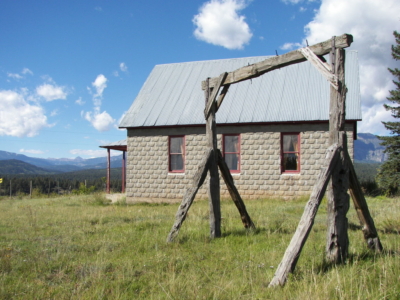
Sierra: Were you born up there?
Dennis: I was actually born in Durango. My mom went to the hospital in Durango. I don’t know of any kids that were born out there. The house we lived in when I first started school there burned down. It wasn’t on my parents land. It belonged to my great uncle. It was a little log cabin. It didn’t have any running water. We had an outhouse and a coal stove.
Miah: Where did you go after the school closed?
Dennis: They made a bus route out there and my mother drove the school bus and we came to town. It was before the elementary school was built. I went to the building that is now the Intermediate School.
Pitcher: Was it ever your chore to pump and haul water?
Dennis: Yes, but that well water we didn’t drink. My cousins hauled drinking water. We used the water from the pump just for washing up. Another chore was to carry coal into the school to build a fire. We had to have a fire everyday because that’s how we warmed up the water to wash our hands. Also, the teacher made us eat soup everyday and that’s how we warmed up the soup.
Miah: Who was the teacher?
Dennis: Her name was Mrs. Willis and I had her the whole time I attended. She was probably in her seventies then.
Sierra: Did you have pets?
Dennis: Yes. We had dogs and I guess we had some cats, too. And we had a horse that was kind of like a pet.
Miah: What do you remember learning?
Dennis: Oh, well, I learned the alphabet. Kids now probably know the alphabet before they go to school. But I didn’t know any of that so I had to learn it all from square one. I remember that and learning how to do math.
Pitcher: What is your favorite memory from school?
Dennis: I suppose I really enjoyed the recess more than anything else. At the end of the school year we had a big community gathering and all the people in the community came and the kids put on a program. We had to play the piano and the violin and recite poetry and do a few things to show that we actually learned something that year. It wasn’t just get your report card and go home.
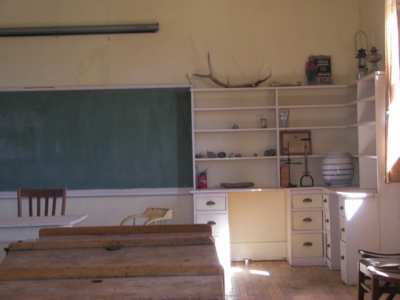
Sierra: What did you eat?
Dennis: We had to take a lunch. We didn’t have a cafeteria so we had to bring sandwiches and your regular lunch box stuff—maybe a cookie or something. And of course soup!
Miah: What hours did you go to school?
Dennis: We went from about 8:00 in the morning until 3:30 or 4:00 in the afternoon, unless one of us was able to sneak up and turn the clock forward a little bit, and then we got to leave early.
Pitcher: Do you still know people here in Pagosa that went to school there?
Dennis: One of my cousins, Bob Kleckner still lives here. There are a few people that live here that went to school there before I did, like John Taylor. My cousin Bob still lives on the land where I lived as a kid.
Jenifer: From how far away did children come to attend the school?
Dennis: My cousins had to come from about five miles away. One time there was a little girl named Delia Hill that lived at Palisade Lakes. She had a pretty long trip to school.
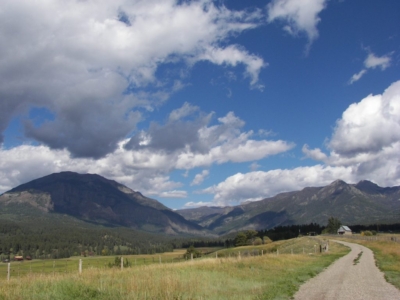
Miah: Did some kids come to school on horseback?
Dennis: No, we really didn’t have a good place for horses during the day. Students either walked or their parents brought them to school.
Sierra: How did your family end up in Pagosa?
Dennis: My great grandmother homesteaded on the west fork where the Boot Jack Ranch is. That was their homestead. My grandfather was a forest ranger and he met my grandmother up there when she was eighteen or nineteen. They got married and bought that place where Bob lives now, where I grew up, and I guess the rest is history.

